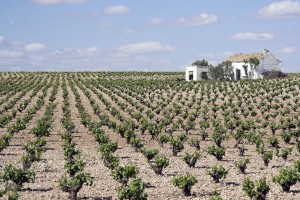The Valdepeñas DO (located in Castilla-La Mancha, Spain) is making some changes! The EU has recently approved a modification to the Pliego de Condiciones for the region, as announced and published in the January 9, 2020 edition of the Official Journal of the European Union.
The wines approved for production in the Valdepeñas DO make up a long list. Red, white, rosé, and sparkling wines are all produced—and most of these may be made in a range of styles relating to aging (including roble, crianza, reserva, and gran reserva), as well as in differing levels of sweetness (seco, semi-seco, semi-dulce, or dulce).
The red and rosé wines of the Valdepeñas DO are based on Tempranillo (Cencibel) and are also allowed to include Cabernet Sauvignon, Garnacha, Merlot, Petit Verdot, and/or Syrah. White wines are typically based on Verdejo and may also include Macabeo, Chardonnay, Sauvignon Blanc, Airén, and/or Muscat (Moscatel).
Today’s story, however, applies to just one style of wine, defined on the Pliego de Condiciones as Tinto Tradicional. This “traditional” style of wine—once considered the signature version of the region’s wines—is light red in color (clarete) and produced using a mixture of red and white grapes. Previously, Tinto Tradicional was required to be produced using a minimum of 50% red grapes. With the modification, the new standard requires a minimum of 85% red grapes in the blend.
According to Florencio Rodríguez, Provincial Secretary of the Asociación Agraria Jóvenes Agricultores–Ciudad Real (ASAJA Ciudad Real), the change was needed to in order to modernize the image of the Valdepeñas DO and to keep up with the increasing demand for more flavorful wines with distinct varietal character.
The Valdepeñas DO is almost completely surround by the much larger La Mancha DO. The climate of Valdepeñas is warm/hot continental, and the region is quite dry—the mountains of the Sierra Morena located just to the west (defining the edge of the Meseta Central) provide a significant rain shadow.
The name of the region translates to “Valley of the Rocks” and refers to the region’s unique rock formations and rocky topsoil.
References/for more information:
- EU Approval Valdepenas Modification
- Pliego de Condiciones Valdepenas-with proposed modifications
- Publication in the Official Journal of the European Union
- Comments from Provincial Secretary Florencio Rodríguez
- http://vinosvaldepenas.com
- https://www.clm24.es/articulo/ciudad-real/dop-valdepenas-eleva-50-85-proporcion-uva-tinta-vino-tradicional/20200109183559266616.html?fbclid=IwAR0HtkoX5lToVNGv_5B3wVH-3w8FDDFrDqt54woEorG99bcHG6NUINUKf5I
Post authored by Jane A. Nickles…your blog administrator: jnickles@societyofwineeducators.org

